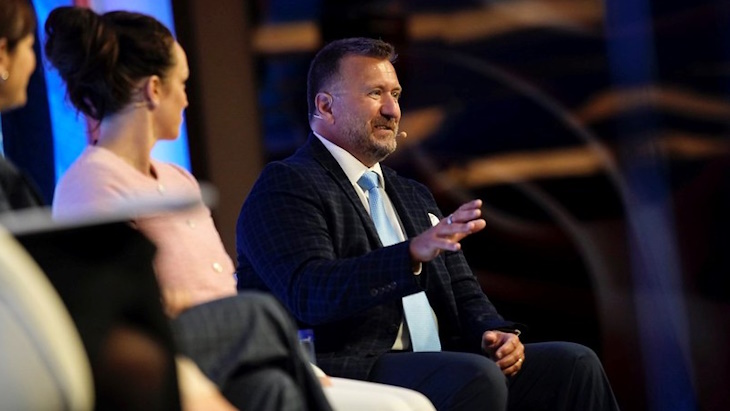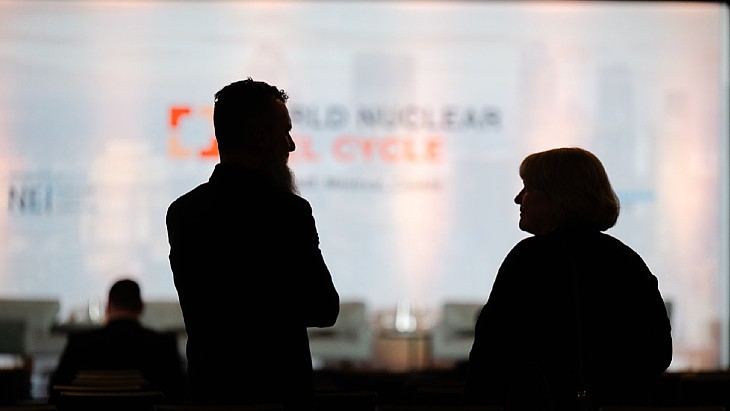The economic reality of Hinkley Point C
In a meeting with British parliamentarians yesterday, EDF Energy dispelled the myths surrounding the economics of the Hinkley Point C nuclear power plant project.
Executives from the company stressed that the strike price agreed with government for electricity generated by the plant had not escalated, that financing for the project was already in place, that the cost of alternative energy sources would not be lower for consumers, and that the delay to the Flamanville project was not relevant to Hinkley.
CEO Vincent de Rivaz, Director of Strategy and Corporate Affairs Paul Spence and Managing Director of Nuclear New Build Humphrey Cadoux-Hudson gave evidence to the House of Lords Economic Affairs Committee in its inquiry The Economics of UK Energy Policy. They took part as witnesses in the inquiry's session 'Taking the nuclear option: Is it the solution to the UK's energy needs?'
Strike price
Asked why the strike price for Hinkley Point C had increased from the £50/MWh EDF Energy had suggested to government in 2009 to the £92.50/MWh the two sides agreed in 2013, de Rivaz denied the £50/MWh figure and that any change had occurred.
"I don't know where the figure of £50/MWh comes from. The negotiations we had with government in 2013 never contemplated a figure so low," de Rivaz said. "We didn't give any number to the government based on Hinkley Point C between 2009 and 2013. We were very active during that period in securing the Generic Design Assessment and so we could not give any numbers on cost before having the design stabilised through this process.
"During this period, we also, and in a very short space of time, secured planning approval, in March 2013. It was from then that we started to put numbers on cost to the British government and proposed the strike price."
The £92.50 negotiated in 2013 is based on the cost estimate of £18 billion [£28 billion], he said. "It has not changed since then."
De Rivaz said the agreement with government had been "scrutinised by Brussels", which had agreed "the cost was justified and that 5% was indeed a fair return".
He was referring to the European Commission's conclusion in October 2014 that revised UK plans to subsidise the construction and operation of a new nuclear power plant at Hinkley Point to be in line with EU state aid rules.
In 2015, a "new layer of scrutiny" followed, de Rivaz said, when EDF invited its Chinese partners to invest in the project. Under a deal agreed in October that year, China General Nuclear (CGN) will invest £6 billion in Hinkley Point C. Under a Strategic Investment Agreement, EDF's share in the project will be 66.5% and CGN's will be 33.5%. EDF said it intends to offer other investors stakes in the £18 billion project, but will keep at least a 50% stake itself.
Hinkley Point C received a long-awaited and positive final investment decision from the EDF board on 28 July, only for the UK government to immediately postpone signing its supporting agreements. Prime Minister Theresa May said a review of the deal would be carried out before the government committed its support. On 15 September, it announced its approval of the project, after reaching a new agreement in principle with EDF. However, it introduced certain conditions for foreign investment in future British nuclear power plant projects.
After this approval was given, and the strike price was confirmed, "450 contracts were signed, 200,000 pages of contracts sealing the deals between us and UK government, the Chinese investor and the major contractors," de Rivaz said.
He referred to the financial challenges the EDF Group faces and the strategy it announced in January to deal with them. The Group has a plan in place to "strengthen its balance sheet for its huge program of investment to be affordable", he said. This strategy aims to reduce costs, dispose of non-strategic assets and secure a capital increase of €4 billion, he added.
EDF's investment of £12 billion in Hinkley Point C was "secured in the Spring" and followed the Chinese partner's commitment at the end of 2015 to invest £6 billion, he said. "The financing is in place and the money is already flowing."
No real alternative
Asked whether Hinkley Point C represented value for money when compared with the estimated cost of alternative ways of delivering low-carbon energy, Spence said the government's analysis showed that it was.
Spence told the committee: "The government has looked at a number of different alternative options for Hinkley Point, at whether or not it could be replaced with gas generation or renewables generation - whether wind or solar. Their value for money analysis work identifies that Hinkley Point is competitive with the range of possible outcomes."
Hinkley Point C will provide 7% of the UK's need for electricity from when it starts producing electricity at the end of 2025, he said. The government also has 34 Contracts-for-Difference (CFDs) as part of its renewable energy program which will provide another 7% of UK electricity.
"Those 34 CfDs on average will cost consumers £120-£130/MWh. By contrast, Hinkley will cost consumers £92.50/MWh. So, against that alternative - a mix of offshore and onshore wind - Hinkley Point is cost competitive," he said.
In a comparison with a "suite of" combined cycle gas turbines (CCGTs), he said, "the two fundamental questions become, what is the cost of the gas that might be burned in those CCGTs and what is the cost of the carbon dioxide that might be emitted?" The government has concluded that the strike price for Hinkley Point of £92.50 "compares favourably" with the financial and climate costs from CCGTs, he added. "There are scenarios where the cost of those gas stations could be lower if gas prices stay low, but the reality is we would not meet our objective to decarbonise the economy," Spence said.
"The government has concluded - and, from what we have seen, we support their analysis - that the most cost-effective solution is one that has nuclear as part of the mix for the total system cost. If the government had concluded it was a solution that involved the use of intermittent [energy sources] - whether that's wind or solar generation - as an alternative, then we would have needed to make sure there was either storage or backup generation in place. The grid would need to have been larger and the net result of those would be an additional cost of roundabout £10-15/MWh that would be required on top of the strike price that the consumers will pay for the generation. All in all, that's why we believe Hinkley, at £92.50, is a good first-of-a-kind deal for the UK."
EPR projects
Asked about the impact on cost of any delay to completing construction of Hinkley Point C, de Rivaz said the two European Pressurized Reactors (EPRs) under construction at Taishan in China are about to start their commissioning phase with hot functional tests.
"Can you imagine for one second that the company building these two EPR reactors in China, CGN, would invest £6 billion in the EPRs in Somerset if they were not fully confident in the technology and in our ability to deliver?" he said. "The Flamanville project in France has had a lot of challenges, but it is now certain to succeed and commissioning will take place in 2018."
Cadoux-Hudson added: "We cannot compare what has been the initial cost and schedule which we set at the start of Flamanville, or deduce from this that we have some weaknesses in our ability to deliver Hinkley Point C. We have learned the lessons."
EDF Energy has put together a "very detailed project with tens of thousands of stats", which has been reviewed by its shareholders and a "number of independent experts".
"More importantly than that, the elements of that schedule have been signed on to by our supply chain," he said. "We're building some sections of the plant in mock-up so that the teams can train on building. That's needed in the UK because we haven't built this sort of equipment for a long time. And we've gone through an enormous amount of trouble to ensure we have built, together with our supply chain, a 4-D model so we can demonstrate the sequence and timing and effort required to build the project on time and on budget."
Asked what compensation the government would receive if Hinkley Point C is completed later than scheduled in 2025, he said, "There is no direct compensation for government of alternative supplies, but there is a very strong incentive in the contract which is if we're delayed, then we carry the cost of an enormous construction investment for a period with no return. And as the contract is delayed the length of the contract will get shorter. The contract has built in a very strong incentive on us to build on time and on budget."
Asked why EDF Energy believes Hinkley Point C "can be built better in Britain, where there has been no new build for years, than it can in France", Cadoux-Hudson said, "The key to all of this is that we are in a position, through the GDA process we've been through, and the lessons that we've got out of the other stations, to start with a complete design."
UK regulators formally approved EDF's EPR design for construction in the UK in December 2012, saying it meets regulatory expectations on safety, security and environmental impact.
Cadoux-Hudson added: "It is a complete design that we have now worked through in terms of planning with our supply chain and all of that is now reflected in a hugely detailed project plan running to the end of construction. You cannot compare that state of readiness with the state of readiness at the beginning of either the Flamanville or the Taishan projects."
The UK's supply chain is "of high quality", de Rivaz said.
"I know this for a fact because they were our partners on the existing nuclear fleet. We bought British Energy at the beginning of 2005. In its last year, British Energy produced 40 TWh. This year, we have produced more than 64 TWh - an increase of more than 60%. In the last seven years we have increased the [operating period] of the AGR fleet by 8.3 years on average and improved by a factor of two the safety performance of these plants.
"This has largely to do with the people working in this industry in our supply chain and they have done a remarkable job."
Researched and written
by World Nuclear News
_59102.jpg)
_49833.jpg)
.jpg)







_50521.jpg)

